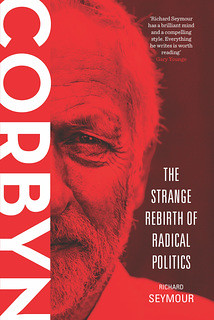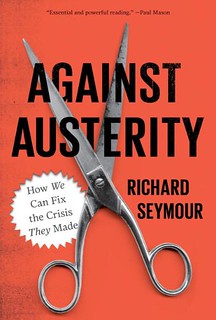Saturday, February 17, 2007
Regnant Mayhem: Mike Davis on the car bomb. posted by Richard Seymour

Over the last week, car bombs have struck in Canada, Algeria, Iran and Iraq. That's a very short-range sample. How about since 2000? We'd have to add Indonesia, Tunisia, Chechnya, Russia, Colombia, Pakistan, Israel, Peru, Saudi Arabia, India, Kenya, Afghanistan, Sri Lanka, Kosovo, Thailand, and Turkey. If we went back to 1990, we'd have to include the United Kingdom, the United States of America, Argentina, Spain, Italy, the north of Ireland, Dagestan and Tanzania. There is not a continent aside from Antarctica on which the car bomb hasn't struck in the last thirty years. Indeed, as Mike Davis discusses in his new book Buda's Wagon: A Brief History of the Car Bomb, it is a technology that has been everywhere since its first deployment by the anarchist Mario Buda in Wall Street in 1920, and is still going places. I say 'car bomb', although as often it involves trucks, vans or in the first instance, a wagon. Davis clarifies that he uses the term as short-hand for what the Pentagon refers to as a "Vehicle Borne Improvised Explosive Device". One could therefore include the attacks on the World Trade Centre in the same category: a car bomb "with wings" as Davis puts it.
 Mobile, covert and deadly, this mode of destruction was pioneered by insurgent movements, but has also been globalised by state-intelligence networks in Vietnam (where the technique was first used by the CIA), Algeria (where it was used by the OAS with some assistance from the CIA), Ireland (where strong evidence suggests that MI5 planned and conducted a deadly series of bombings in Dublin in 1972), Afghanistan (where the CIA's assets used it against the Soviet invaders), Lebanon (where the CIA paid local assets to try and knock of Hezbollah's leaders) and Iraq (where the CIA's assets, the Iraqi National Accord, blew up schoolbuses in the 1990s). Shin Bet were also involved in car bombings in Lebanon in 1982, as were Syrian intelligence, who bombed the Iraqi embassy in retaliation for Hussein's support for the Syrian branch of the Muslim Brothers. Insurgent groups using the weapon include the Zionist Stern Gang, the Palestinian resistance to the Zionists (in which blue-eyed British deserters participated), the Viet Minh, Sendero Luminoso (Shining Path), the IRA, Hezbollah, ETA (Basque separatists), various Iraqi resistance groups and the LTTE (Sri Lankan Tamil Tigers). Criminals using it include the Sicilian Cosa Nostra and Colombian drug lord Pablo Escobar. These three groups overlap in various ways: what is sometimes called "black globalization" can involve both insurgent outfits and intelligence units deriving funding from massive criminal activity (clearly, the opium business whether in the Golden Triangle or Afghanistan fits this bill beautifully), while at the same time insurgencies are often either sponsored or heavily infiltrated by intelligence departments.
Mobile, covert and deadly, this mode of destruction was pioneered by insurgent movements, but has also been globalised by state-intelligence networks in Vietnam (where the technique was first used by the CIA), Algeria (where it was used by the OAS with some assistance from the CIA), Ireland (where strong evidence suggests that MI5 planned and conducted a deadly series of bombings in Dublin in 1972), Afghanistan (where the CIA's assets used it against the Soviet invaders), Lebanon (where the CIA paid local assets to try and knock of Hezbollah's leaders) and Iraq (where the CIA's assets, the Iraqi National Accord, blew up schoolbuses in the 1990s). Shin Bet were also involved in car bombings in Lebanon in 1982, as were Syrian intelligence, who bombed the Iraqi embassy in retaliation for Hussein's support for the Syrian branch of the Muslim Brothers. Insurgent groups using the weapon include the Zionist Stern Gang, the Palestinian resistance to the Zionists (in which blue-eyed British deserters participated), the Viet Minh, Sendero Luminoso (Shining Path), the IRA, Hezbollah, ETA (Basque separatists), various Iraqi resistance groups and the LTTE (Sri Lankan Tamil Tigers). Criminals using it include the Sicilian Cosa Nostra and Colombian drug lord Pablo Escobar. These three groups overlap in various ways: what is sometimes called "black globalization" can involve both insurgent outfits and intelligence units deriving funding from massive criminal activity (clearly, the opium business whether in the Golden Triangle or Afghanistan fits this bill beautifully), while at the same time insurgencies are often either sponsored or heavily infiltrated by intelligence departments. The use of the car bomb increased dramatically in the 1990s and it is no secret that there is hardly a week in Iraq without a sequence of such deadly attacks. It is the latter that I shall come to discuss in a bit of detail in a minute, since Davis hits on some analysis that is of immediate, compelling significance. But what is the point of a book about car bombs, and what does the trend mean? Davis acknowledges that narrating the development of a technology, even one as horrifying as this, "risks self-absorption and exaggeration". He reminds us, however, of Marx's insight that the meaning of technology resides partially in how it is embedded in specific social forms. Steam power meant little to the Alexandrian Greeks when slave labour was so abundant - similarly, he notes, the car bomb had been invented long before it became widely used. The real rise of this tactic came about primarily as a result of its use in Beirut and Kabul by the CIA and ISI, and it has proliferated "in the thousand fissures of ethnic and religious enmity that globalization has paradoxically revealed. It also flourishes in the badlands of extreme inequality, on the edges of poor cities, and even in the embittered recesses of the American heartland". The advantages of this weapon impress themselves upon the urban guerilla warrior: they are the "poor man's air force", because they are "stealth weapons of surprising power and destructive efficiency"; because they are "'loud' in every sense", carrying an impactful message alongside the operational function; because they are cheap, inasmuch as it costs only a few thousand dollars to inflict billions of dollars of damage in the cases of both the attack on the FBI headquarters in Oklahoma and the 1993 WTC attack; they are easy to organise and information on how to do so is simple to obtain; being indiscriminate, they are ideal for the purpose of creating a strategy of tension and demoralising whole societies; they are very anonymous, leaving little forensic evidence; finally, most importantly, they enfranchise marginal forces with neither significant constituencies nor mass legitimacy, and add "claws" to resistance groups with genuine support.
The use of the car bomb increased dramatically in the 1990s and it is no secret that there is hardly a week in Iraq without a sequence of such deadly attacks. It is the latter that I shall come to discuss in a bit of detail in a minute, since Davis hits on some analysis that is of immediate, compelling significance. But what is the point of a book about car bombs, and what does the trend mean? Davis acknowledges that narrating the development of a technology, even one as horrifying as this, "risks self-absorption and exaggeration". He reminds us, however, of Marx's insight that the meaning of technology resides partially in how it is embedded in specific social forms. Steam power meant little to the Alexandrian Greeks when slave labour was so abundant - similarly, he notes, the car bomb had been invented long before it became widely used. The real rise of this tactic came about primarily as a result of its use in Beirut and Kabul by the CIA and ISI, and it has proliferated "in the thousand fissures of ethnic and religious enmity that globalization has paradoxically revealed. It also flourishes in the badlands of extreme inequality, on the edges of poor cities, and even in the embittered recesses of the American heartland". The advantages of this weapon impress themselves upon the urban guerilla warrior: they are the "poor man's air force", because they are "stealth weapons of surprising power and destructive efficiency"; because they are "'loud' in every sense", carrying an impactful message alongside the operational function; because they are cheap, inasmuch as it costs only a few thousand dollars to inflict billions of dollars of damage in the cases of both the attack on the FBI headquarters in Oklahoma and the 1993 WTC attack; they are easy to organise and information on how to do so is simple to obtain; being indiscriminate, they are ideal for the purpose of creating a strategy of tension and demoralising whole societies; they are very anonymous, leaving little forensic evidence; finally, most importantly, they enfranchise marginal forces with neither significant constituencies nor mass legitimacy, and add "claws" to resistance groups with genuine support. Aside from its origins in conflicts emerging from the current phase of global capitalism, there is its effect on the social landscape: Davis describes the proliferation of 'rings of steel' around state buildings, financial areas and privileged residential zones, while warring parties probe soft targets for areas of vulnerability (which, if they are persistent enough, they are bound to find). That is, the Green Zone, whose predecessors can be found in Belfast city centre and in the City of London, will be globalized alongside a vast Red Zone embracing most of humanity. In Davis' last book, Planet of Slums, we were introduced to the devastating facts about the cities of the future in which most demographic growth is to take place in urban corridors connecting megalopolises of the global south, in which there is urbanisation without growth, in which the greatest employment growth is to take place in the casual sector. This is a certain recipe for conflict, and the global ruling class will secrete itself in high-tech villas behind separation walls, with hired retainers guarding the peripheries and surreal serenity within. To reduce the threat of car bombs, it would be necessary to 'decommission minds', to reform the society in ways that tended toward the pacification of conflict. There is, notes Davis, no sign of such changes coming soon - quite the contrary.
Aside from its origins in conflicts emerging from the current phase of global capitalism, there is its effect on the social landscape: Davis describes the proliferation of 'rings of steel' around state buildings, financial areas and privileged residential zones, while warring parties probe soft targets for areas of vulnerability (which, if they are persistent enough, they are bound to find). That is, the Green Zone, whose predecessors can be found in Belfast city centre and in the City of London, will be globalized alongside a vast Red Zone embracing most of humanity. In Davis' last book, Planet of Slums, we were introduced to the devastating facts about the cities of the future in which most demographic growth is to take place in urban corridors connecting megalopolises of the global south, in which there is urbanisation without growth, in which the greatest employment growth is to take place in the casual sector. This is a certain recipe for conflict, and the global ruling class will secrete itself in high-tech villas behind separation walls, with hired retainers guarding the peripheries and surreal serenity within. To reduce the threat of car bombs, it would be necessary to 'decommission minds', to reform the society in ways that tended toward the pacification of conflict. There is, notes Davis, no sign of such changes coming soon - quite the contrary.There is no romanticism in this book: Davis remarks that the car bomb is a weapon whose use is "guaranteed to leave its perpetrators awash in the blood of innocents", a "categorical censure" that applies "even more forcefully to the mass terror against civilian populations routinely inflicted by the air forces and armies of so-called 'democracies'". He repeatedly describes the devastating effects of these devices on their human victims. Their efficacy in accomplishing some military goals is without question, and those who use it are not simply irrational, but it inherently tends toward the brutalisation of civilians, toward immense tactical cruelty, as the targets become 'softer'. Genuine liberation struggles have been discredited and undermined by the use of car bombs, he argues.
 And this is where we come to Iraq, for there is no doubt that the resistance is entitled to resist and is entitled to do so with force. Yet while most of the resistance attacks have been characterised by roadside attacks on military convoys, mortars, rockets and gunfire exchanges, the bloodiest ones have been car bombs. These have been directed largely by "foreign fighters", the transnational takfiri elements such as the supporters of the late Zarqawi, and their relationship with the goals of the domestic resistance is complex. The earliest wave of such attacks seriously undermined several props of the occupation such as the United Nations, the presence of several foreign armies and staff. They also drove the occupiers into their heavily fortified Green Zone in the first place and seriously undermined the attempts to build up a client state, by attacking police and army recruitment stations. The military logic of such attacks is transparent, even if the cost in civilian lives has been enormous.
And this is where we come to Iraq, for there is no doubt that the resistance is entitled to resist and is entitled to do so with force. Yet while most of the resistance attacks have been characterised by roadside attacks on military convoys, mortars, rockets and gunfire exchanges, the bloodiest ones have been car bombs. These have been directed largely by "foreign fighters", the transnational takfiri elements such as the supporters of the late Zarqawi, and their relationship with the goals of the domestic resistance is complex. The earliest wave of such attacks seriously undermined several props of the occupation such as the United Nations, the presence of several foreign armies and staff. They also drove the occupiers into their heavily fortified Green Zone in the first place and seriously undermined the attempts to build up a client state, by attacking police and army recruitment stations. The military logic of such attacks is transparent, even if the cost in civilian lives has been enormous.  However, there has been a wave of car bombing attacks dedicated to civil war: usually by sectarian Sunni groups against Shia targets. The logic behind these is directly political: as far as the takfiris are concerned, a unified Sunni-Shiite rebellion would probably be a nationalist and secular one, and they would lose out. This was, Loretta Naopoleoni has reported, Zarqawi's repeated stress. By targeting the Shi'ites in their homes, burning them alive in the streets, atomising them in their mosques, they proved that the occupiers couldn't protect the Shi'ites, who turned to militias for protection. The results have proven that the strategy is effective: every time a car bomb went off in Sadr City, for example, a series of attacks was launched on neighbouring Sunni areas. More Sunni bodies appeared with the markings of Black & Decker cordless torture and riddled with bullets. In this respect, the strategy of the takfiris is not at all unhelpful to the occupiers, whose own sectarian strategy is both politically and militarily similar: using the Badr Brigades and the SPCs, they terrorise Sunni areas, stimulating sectarian responses that forestall the development of a national united front and prevent the occupiers from being expelled. What is more, the current drive against the "Shia militias" (which include only the supporters of the anti-occupation Muqtada al-Sadr) is set to disarm areas like Sadr City, remove their roadblocks and make them more vulnerable. Several attackers were able to strike, as Davis notes, thanks to US troops dismantling Mahdi Army controls.
However, there has been a wave of car bombing attacks dedicated to civil war: usually by sectarian Sunni groups against Shia targets. The logic behind these is directly political: as far as the takfiris are concerned, a unified Sunni-Shiite rebellion would probably be a nationalist and secular one, and they would lose out. This was, Loretta Naopoleoni has reported, Zarqawi's repeated stress. By targeting the Shi'ites in their homes, burning them alive in the streets, atomising them in their mosques, they proved that the occupiers couldn't protect the Shi'ites, who turned to militias for protection. The results have proven that the strategy is effective: every time a car bomb went off in Sadr City, for example, a series of attacks was launched on neighbouring Sunni areas. More Sunni bodies appeared with the markings of Black & Decker cordless torture and riddled with bullets. In this respect, the strategy of the takfiris is not at all unhelpful to the occupiers, whose own sectarian strategy is both politically and militarily similar: using the Badr Brigades and the SPCs, they terrorise Sunni areas, stimulating sectarian responses that forestall the development of a national united front and prevent the occupiers from being expelled. What is more, the current drive against the "Shia militias" (which include only the supporters of the anti-occupation Muqtada al-Sadr) is set to disarm areas like Sadr City, remove their roadblocks and make them more vulnerable. Several attackers were able to strike, as Davis notes, thanks to US troops dismantling Mahdi Army controls. The car bomb's horrendous career in Iraq is setting a disastrous precedent: the recent escalation of its use by anti-occupation fighters in Afghanistan indicates, according to Davis, that the transnational Islamist movements have decided to create "one, two, three, many Iraqs!" And it works: there are no magic bullets coming soon. If someone wants to rip apart soft targets in any capital city in the world, they can do so. As long as blizzards of imperialist violence and repression create the recruits for the movements using this tactic, and as long as people can be persuaded to have their arm handcuffed to a steering wheel and their foot taped to an acceleration pedal as they speed toward their immolation, we have not seen the half of it. As long as intelligence agencies are free to destabilise societies and combat insurgencies in secrecy, the car bomb will continue to tear up our global red zone with increasing frequency.
The car bomb's horrendous career in Iraq is setting a disastrous precedent: the recent escalation of its use by anti-occupation fighters in Afghanistan indicates, according to Davis, that the transnational Islamist movements have decided to create "one, two, three, many Iraqs!" And it works: there are no magic bullets coming soon. If someone wants to rip apart soft targets in any capital city in the world, they can do so. As long as blizzards of imperialist violence and repression create the recruits for the movements using this tactic, and as long as people can be persuaded to have their arm handcuffed to a steering wheel and their foot taped to an acceleration pedal as they speed toward their immolation, we have not seen the half of it. As long as intelligence agencies are free to destabilise societies and combat insurgencies in secrecy, the car bomb will continue to tear up our global red zone with increasing frequency.










